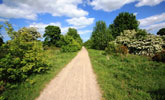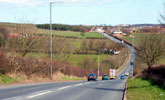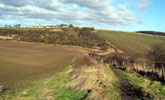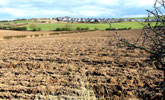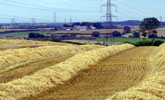Clay Plateau
View interactive map of Broad Landscape Types
Key Characteristics
- Low plateau of flat, gently rolling or undulating terrain.
- Soft magnesian limestones are covered by a thick mantle of boulder clay.
- Heavy, seasonally waterlogged clay soils.
- Mosaic of improved pasture and arable cropping – mostly cereals and oilseed rape.
- Regular or semi-regular patterns of medium and large-scale fields bounded by low hawthorn hedges.
- Few trees – thinly scattered hedgerow ash, oak and sycamore.
- Sparsely wooded – occasional small broadleaved woods and larger conifer plantations.
- Scattered mining villages connected by a well developed network of busy roads.
- Telecommunications masts and pylons frequently feature on the skyline.
- Areas of derelict colliery land, reclaimed land and old clay pits.
- Abandoned railway lines, many in use as cycleways.
- A visually open landscape, broad in scale, with a semi-rural or urban fringe quality in places.
Description
A low plateau of flat, gently undulating or gently rolling terrain. Soft magnesian limestones (dolomites) are overlain by glacial drift – mostly boulder clays with isolated pockets of sands and gravels – often to a substantial depth. Soils are heavy, seasonally waterlogged brown stony clay soils with pockets of lighter calcareous soils where there is no drift. Pockets of peaty clay soils occur in poorly drained areas.
Agricultural land use is mixed with a mosaic of improved pasture and arable cropping of cereals and oilseed rape. Field boundaries are hawthorn-dominated hedgerows, usually low and trimmed in arable areas but occasionally tall and overgrown around pastures. Field patterns are variable but are generally regular or semi-regular. Some date from the enclosure of the town fields of older villages, or enclosures from the manorial wastes associated with individual farms – often called ‘granges’ – from the late 1500s. Others date from the enclosure of open wastes from the mid 1700s – usually indicated by the place name ‘moor’ – and have the characteristic regular grid patterns of land enclosed by surveyors. Field patterns have been heavily disrupted in places by the amalgamation of smaller units into large arable fields.
Tree and woodland cover is low. The landscape is very open with thinly scattered hedgerow oak, ash and sycamore. There are few woodlands other than occasional small broadleaved woods and a number of larger conifer plantations. Areas of scrub and young woodland are found on pockets of derelict colliery land, old railway lines and abandoned grassland.
Historically a sparsely settled landscape of scattered villages and extensive wastes on the heavy and poorly drained soils of the central plateau. Some older villages and farms survive. Most are of local limestone, or more durable Carboniferous sandstones imported from the west of the county, with roofs of red clay pan tile. Mining villages are scattered across the plateau, some having absorbed older villages. They are made up of buildings from a number of periods including Victorian terraced housing of red brick and slate, estates of the inter-war and post-war public housing and more recent private development. Settlement edges are abrupt or fringed by allotment gardens and pony paddocks. Villages are connected by a relatively dense network of busy roads, and old railway lines – many now in use as recreational cycleways.
Coal mining has had a substantial influence on the landscape. Much of its legacy has been removed by land reclamation in recent years, but some areas of dereliction remain. Areas of land restored to agriculture or forestry are found around the colliery villages. Many villages also had small brickworks associated with them and old flooded clay pits are common. Telecommunications masts and the pylons of overhead transmission lines feature frequently on the skyline.
The landscape is visually very open and broad in scale, and has a semi-rural or urban fringe quality in most places coming from its dense settlement pattern, busy roads, overhead services and areas of derelict land.
Broad Character Areas
The Clay Plateau landscape type is represented by a single Broad Character Area.
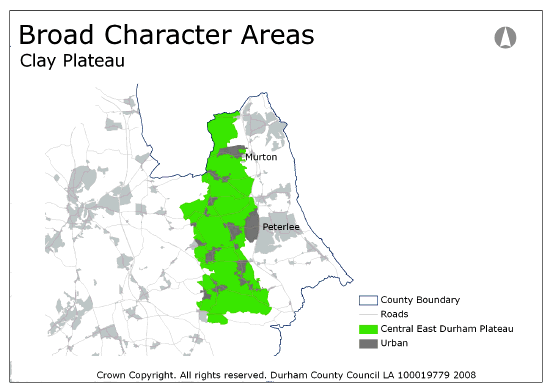
View interactive map of Broad Character Areas
The Central East Durham Plateau. The plateau runs from the county boundary north of Murton to the Tees Plain south of Station Town and Trimdon Colliery, defined in the east by the A19. An open landscape of gently rolling, in places almost flat, farmland; a patchwork of arable cropping and improved pasture. Old pre-enclosure hedges or those of the later enclosures of the ‘moors’ are low and trimmed or tall and overgrown and there are few hedgerow trees. The landscape around Wingate and Wheatley hill is heavily wooded with large mixed plantations, but elsewhere there are few woodlands. Colliery villages are scattered across the plateau connected by minor roads. Overhead power lines are regular features of the skyline. The area is crossed by a number of disused railway lines including the Haswell to Hart walkway.
Local Landscape Types
Local Landscape Types and sub-types are identified at a detailed level and reflect localised variations in landscape characteristics. A map of the Local Landscape Types and sub-types for the Clay Plateau Broad Landscape Type can be downloaded as a PDF below:
Local Landscape Types – Clay Plateau Map (PDF, 851kb)
Alternatively you can view an interactive map of Local Landscape Types for the whole of the East Durham Limestone Plateau County Character Area.
For a written description of the Local Landscape Type and sub-types for the East Durham Limestone Plateau County Character Areas download the following PDF:
East Durham Limestone Plateau (PDF, 1Mb)
Further Information
Further Broad Landscape Types with in the East Durham Limestone Plateau
or

